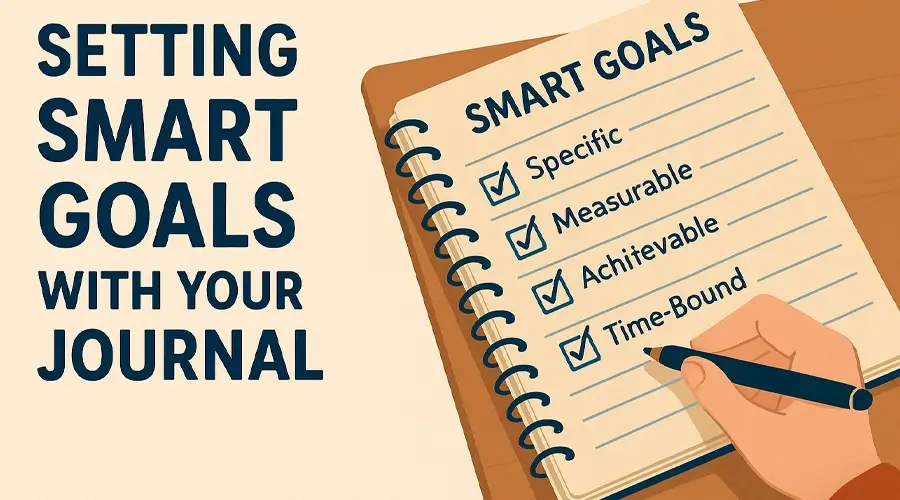We’ve all done it. Scribbled down New Year’s resolutions, made mental promises to start working out, eat healthier, launch that side hustle—or simply live more intentionally. But somewhere between dreaming big and actually doing the thing, the momentum dies out. Days pass, habits slip, and the goals we set with so much excitement slowly fade into the background.
So, why do we set goals but rarely achieve them?
The problem isn’t ambition—it’s clarity and follow-through. Most goals fail not because they’re impossible, but because they’re vague, untracked, and disconnected from our daily routines. You might want to “get fit” or “save more money,” but without a system to break that intention into manageable, trackable steps, it’s just a hope floating in your head.
That’s where the power of journaling steps in.
When you put your thoughts on paper, something changes. You slow down. You reflect. You start shaping loose ideas into clear, structured intentions. A simple notebook becomes a space where you not only dream but also design a roadmap. Writing regularly allows you to track your goals, spot obstacles early, and celebrate small wins along the way. It transforms your ambitions from “someday” into “step one.”
This article introduces you to a powerful practice that combines intention with structure:
Journaling for goals.
Specifically, we’ll explore how to use the SMART goal framework inside your journal—not just to set better goals, but to stay aligned with them in a way that feels human, flexible, and deeply motivating. Because when your journal becomes your goal-setting partner, you’re not just writing—you’re moving forward.
Why Most Goals Fail (and How Your Journal Fixes That)
Let’s be honest—goal setting can be thrilling for about five minutes. You feel a rush when writing “Lose 10 pounds” or “Start a business” at the top of your to-do list. But within a week (or less), life gets noisy. Distractions multiply. Motivation fades. And that inspiring goal? It becomes just another forgotten note in your phone or planner.
Here’s the real reason most goals fail: they live in your head, not in your habits.
When goals are vague (“I want to get better at time management”), they offer no direction. When they’re not tracked, they disappear into the chaos of daily life. When they’re too rigid or unrealistic, they feel like a burden rather than an inspiration. And when we hit roadblocks, we tend to give up instead of adjusting course.
That’s where journaling becomes more than a feel-good ritual—it becomes your system.
A goal journal doesn’t just help you remember your goals; it helps you engage with them daily. Writing down your objectives, breaking them into steps, tracking your mood, documenting challenges, and celebrating tiny wins—all of this turns your journal into an actual accountability partner. It keeps your goals visible, alive, and flexible.
Using a dedicated goal tracking journal, or simply adding goal-focused pages to your existing notebook, creates a feedback loop. You write → you act → you reflect → you adjust. That’s powerful.
Think of journaling for goals as a self-designed GPS. You still choose the destination, but now you can actually track the route, make turns when needed, and avoid driving in circles.
The best part? You don’t need a fancy planner or a Pinterest-worthy bullet journal. You just need to show up on the page with honesty and intention.

The SMART Framework Explained (Without the Boredom)
Let’s face it—when people hear “SMART goals,” their eyes sometimes glaze over. It sounds corporate. Dry. Like something you’d write in a team-building workshop and never revisit.
But trust me, when used inside your journal, the SMART framework becomes something completely different: personal, practical, and surprisingly powerful.
SMART is an acronym that stands for:
-
S — Specific
-
M — Measurable
-
A — Achievable
-
R — Relevant
-
T — Time-bound
Sounds simple enough, but let’s bring it to life with examples that actually make sense for your world—whether you’re juggling a career, relationships, or personal growth.
S — Specific: Don’t Just “Get Healthy”
Vague goal: “I want to get healthier.”
SMART version: “I’ll cook three plant-based dinners at home this week.”
In your goal journal, being specific forces you to get clear about what you actually want to do—not what sounds good.
M — Measurable: Progress You Can Track
If you can’t measure it, how will you know it’s working?
Example: “I’ll save $200 this month by bringing lunch from home.”
Use a goal tracker in your journal—a simple grid, a bar you fill in, or just a tally—to make progress feel real.
A — Achievable: Stretch, Don’t Snap
Your journal is not a fantasy zone—it’s your personal strategy board.
Unrealistic goal: “I’ll write a book in a week.”
Achievable version: “I’ll write 500 words each morning for the next 10 days.”
Tiny, repeatable actions build serious momentum.
R — Relevant: Goals That Actually Matter to You
This is where many people fail. They chase goals that look good on Instagram but mean nothing to them.
Ask yourself: Does this goal align with my current season of life?
Relevant journal entry: “I’m focusing on building consistency at the gym, not chasing aesthetics.”
T — Time-bound: Give It a Deadline or It’ll Drift
Deadlines give shape to your ambition.
Instead of: “I want to learn Spanish someday.”
Try: “I’ll complete the first 10 lessons on Duolingo by the end of this month.”
In your journal, set dates, review them, and adjust as needed. Flexibility is allowed—drifting aimlessly is not.
Using the SMART framework in your journaling for goals doesn’t mean being rigid. It means being realistic and intentional. You’re not just making goals—you’re giving them roots, structure, and space to grow.
Visualizing Progress: Your Journal as a Feedback Mirror
Staying motivated is hard when progress feels invisible. And in the chaos of daily life, we often forget how far we’ve actually come.
That’s where journaling for goals turns into something more than just writing. It becomes a visual feedback system—a way to see your effort, track your momentum, and reflect on your growth in real time.
Think of your journal not only as a record of what you’ve done, but as a mirror that shows what’s working.
Use Habit Trackers to Spot Patterns
A simple habit tracker—a grid, a row of checkboxes, or even colored dots—lets you see consistency at a glance. Whether you’re meditating, drinking more water, or writing each day, tracking it visually gives your brain the dopamine hit it needs to stay engaged.
💡 Tip: Start small. Track just 1–2 core habits connected to your SMART goals, like “30 mins writing” or “no social media before 10 AM.”
Create Goal Maps to See the Bigger Picture
A goal map is a visual breakdown of a big goal into smaller, connected tasks. Mapping your goals gives you clarity. Instead of facing one big scary mountain, you start seeing a path with manageable steps.
💡 Use mind maps, timelines, or step-by-step lists in your journal to organize complex goals.

Design Monthly Spreads for Snapshot Reviews
A monthly spread gives you space to reflect on wins, struggles, and tweaks. It’s your checkpoint—your chance to ask, “Am I still on the right path?”
Include sections like:
-
What went well?
-
What felt hard?
-
What can I adjust next month?
💡 These questions, written consistently, train your brain to approach progress with curiosity instead of judgment.
Past Entries = Proof You’re Evolving
Flipping through your older journal pages can be surprisingly empowering. You’ll notice shifts in your mindset, achievements you forgot to celebrate, and patterns you didn’t see before. That’s not just journaling—it’s goal tracking in its most human form.
When you feel stuck, these reflections act like mini pep talks from your past self. They remind you that progress isn’t always loud—but it’s always there.
In short, visual journaling transforms your notebook into a dynamic, responsive tool. It doesn’t just hold your goals—it interacts with them. And when you can see your growth, you’re far more likely to keep going.
Obstacles? Write Them Out. Literally.
Even the best SMART goals hit roadblocks. Motivation dips. Life throws curveballs. Plans don’t go the way you expected. And that’s okay.
But instead of bottling it up—or worse, quitting—use your journal as a safe space to unpack what’s going on. This is where reflective journaling becomes your superpower.
Use Your Journal as a Mind-Clearing Tool
When you feel stuck, open your notebook and ask:
“What exactly is making this feel hard right now?”
Write freely. Don’t worry about grammar, structure, or sounding smart. Just get it out. You’ll be surprised how naming the obstacle—whether it’s fear, overwhelm, lack of time, or burnout—can instantly reduce its power.
💡 Bonus: Over time, you’ll start to see patterns in your journaling for goals. Are the same blocks popping up again and again? That’s data you can work with.
Write to Solve, Not Just to Vent
Yes, venting helps—but don’t stop there. Once you’ve written about the obstacle, go one step further:
-
What’s one thing I can do differently tomorrow?
-
What support do I need right now?
-
Is this goal still relevant, or does it need adjusting?
This kind of self-inquiry transforms your goal journal into a coaching session—led by you.
💡 Try using journal prompts like:
-
“A challenge I faced this week and what I learned from it…”
-
“One mindset shift that could help me keep going…”
Weekly Review Ritual: Tune Your Life with Ink
Goals don’t fail because we’re lazy—they fail because we stop paying attention. In the rush of daily life, we rarely pause to ask: Is this even working?
That’s why building a weekly review ritual is a game-changer in your journaling for goals journey. It’s a moment where you step out of autopilot, reflect with intention, and realign with what matters.
Your goal journal becomes more than a planner—it becomes your coach, accountability partner, and mirror all in one.
How to Build a Weekly Review Ritual (That You’ll Actually Stick To)
Set aside 15–30 minutes at the end of each week. Light a candle, play some music, go to a café—make it feel like something you want to do, not a chore.
In your journal, create a simple review template with questions like:
-
What did I accomplish this week?
-
What challenged me?
-
What am I proud of?
-
What’s one thing I want to improve next week?
💡 Bonus: Add a 1–10 “alignment check” scale. How aligned do you feel with your SMART goals right now?

Identify Patterns Before They Become Problems
One of the underrated benefits of journaling for goals is that it helps you catch issues early. Are you always skipping workouts on Fridays? Always overwhelmed by Tuesday meetings? These are clues—use them.
A weekly review gives you space to notice those patterns, without judgment. From there, you can adjust your strategy, not just your schedule.
Celebrate the Small Wins
Your brain craves recognition. If you don’t acknowledge your progress, it’s easy to feel stuck—even when you’re not.
Each weekly review should include a moment of celebration:
-
A task you finally completed
-
A habit you stayed consistent with
-
A mindset shift you made
These wins matter. Write them down. Highlight them. Draw stars next to them if you want.
💡 Try starting your review with: “One thing that went surprisingly well this week…”
📝 Ready to turn your thoughts into actionable goals?
Download VERBOAI and let AI guide your journaling journey—one smart entry at a time.
Conclusion: It’s Not Just a Journal—It’s Your Goal Partner
Let’s rewind for a second.
You’ve learned how to set SMART goals—goals that are Specific, Measurable, Achievable, Relevant, and Time-bound. But more importantly, you’ve discovered how to embed those goals into your daily life through journaling.
Because here’s the truth: goals don’t live on vision boards or in motivational quotes. They live in action. In repetition. In the pages you return to, even when you don’t feel like it.
That’s what makes journaling for goals so powerful. It’s not a passive activity. It’s a tool. A mindset. A practice that keeps you honest, focused, and resilient. Your journal holds your intentions, your progress, your doubts, and your breakthroughs. All of it matters.
And when you commit to showing up on the page—whether to plan, reflect, celebrate, or recalibrate—you’re not just writing.
You’re building momentum. You’re building a life on purpose.
So don’t wait for the perfect notebook or the perfect time. Start where you are, with what you have. Write one SMART goal. Reflect on one small win. Track one tiny habit.
Because the journey from intention to impact doesn’t require perfection.
It just needs ink, honesty, and a little consistency.



